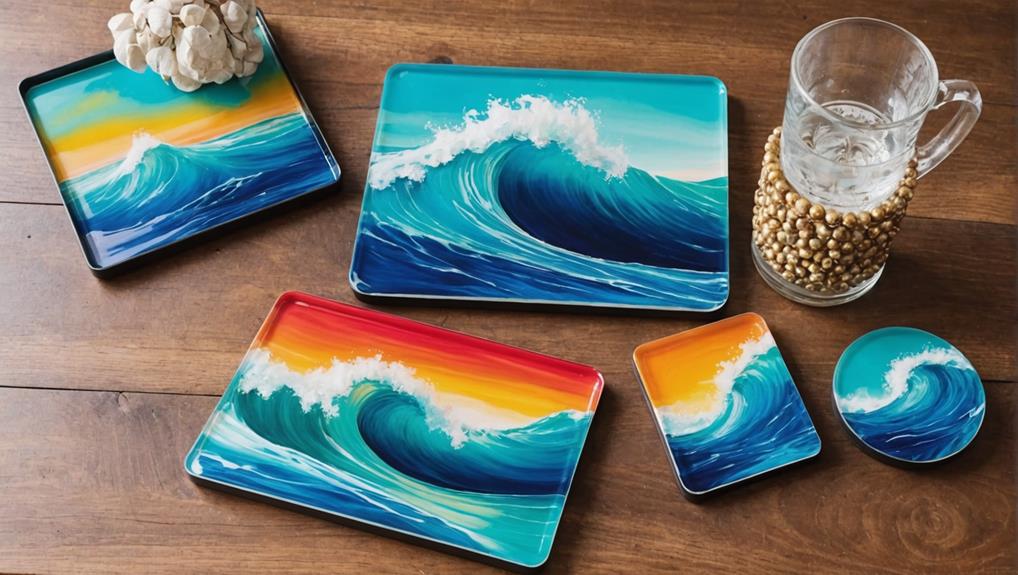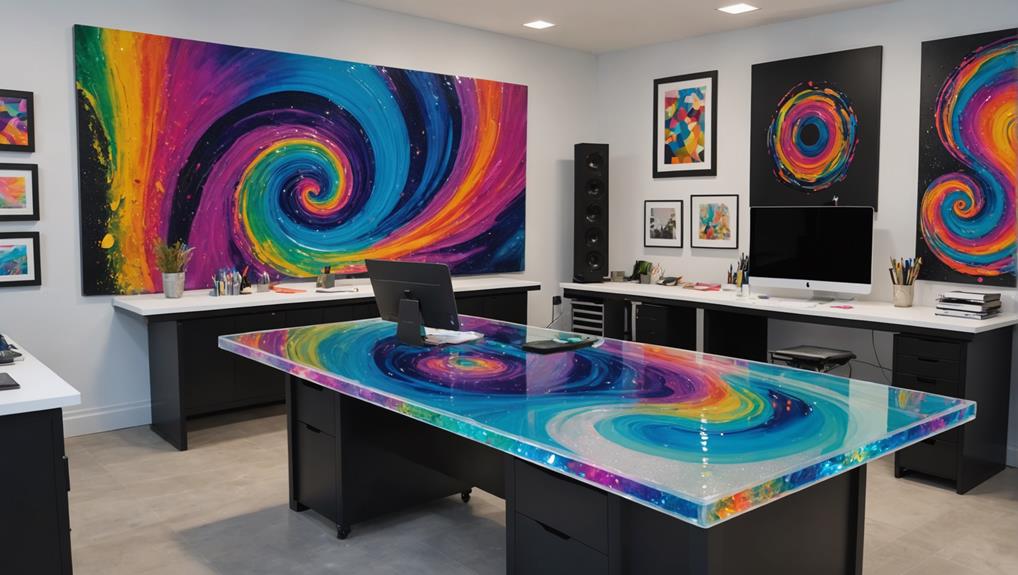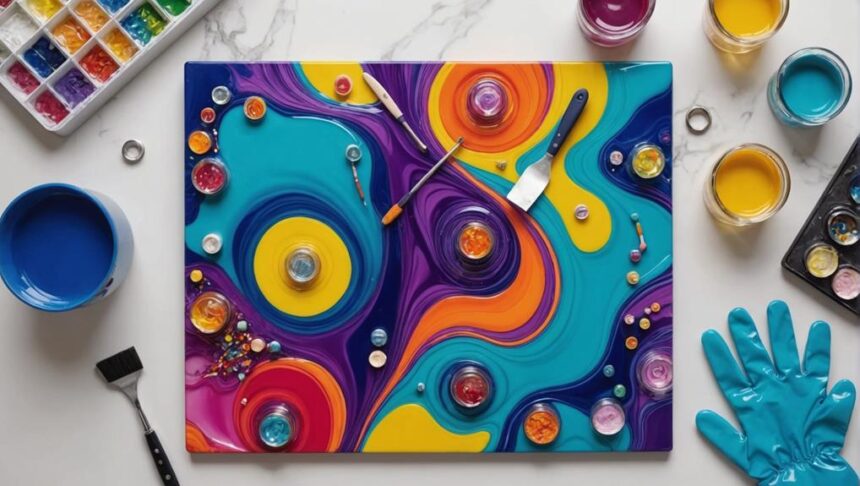Epoxy art resin is like magic in a bottle! It's a two-part liquid that, when mixed together, transforms into a shiny, super-tough material perfect for art. You can use it to make stunning, colorful pieces like ocean wave paintings, funky coasters, and even intricate jewelry. Mix in pigments for vibrant colors, and use a heat gun to zap any pesky bubbles. Just don't forget the safety gear—gloves, goggles, and a mask are a must! Whether you're embedding flowers or creating abstract swirls, the creative possibilities are endless. Stick around, and you'll discover tons of cool ways to use this amazing stuff!
Key Takeaways
- Epoxy art resin is a two-part synthetic polymer that cures into a durable, glossy, and clear solid ideal for artistic applications.
- Essential tools include mixing cups, stir sticks, heat guns, and silicone molds to achieve accurate measurement, mixing, and design shaping.
- Safety gear like nitrile gloves, safety goggles, respirators, and proper ventilation are crucial to prevent exposure to toxic fumes and skin irritation.
- Popular techniques include color blending, dirty pour, resin wave, and layering to create dynamic and intricate designs.
What Is Epoxy Art Resin?
Epoxy art resin is a specialized two-part synthetic polymer that, when mixed, cures into a durable, glossy solid ideal for various artistic applications.
This fascinating material is made by combining a resin and a hardener. When these two parts come together, they initiate a chemical reaction known as the curing process. This process transforms the liquid mixture into a hard, glass-like finish, perfect for capturing and enhancing the vibrancy of colors in art.
One of the standout epoxy properties is its high clarity. This clarity is like magic, making colors pop and giving artworks a sleek, professional-looking finish. Imagine painting a beautiful sunset and then covering it with a crystal-clear layer that makes the colors even more breathtaking. That's what epoxy can do!
The curing process typically takes between 24 to 72 hours, depending on the product and the environment. This means patience is key, as you'll need to wait for your masterpiece to fully harden and achieve that glossy perfection.
Essential Materials and Tools
When starting with epoxy resin art, the first things you need are the core materials: a two-part epoxy resin system with resin and hardener, mixed in a specific ratio, usually 1:1.
Safety gear like gloves and goggles is critical because you don't want any nasty skin irritations or to breathe in harmful fumes.
To make your art pop, you'll also need mixing cups, stir sticks, a heat gun or butane torch to zap those pesky bubbles, and maybe some silicone molds for cool shapes.
Core Resin Materials
Mixing resin and hardener in precise ratios is essential to achieving the best results in epoxy art projects. This is where resin chemistry comes into play; it's like a science experiment but way more fun! You typically mix resin and hardener in a 1:1 ratio to get that perfect blend. But don't worry, it's not as complicated as it sounds. Think of it like making the perfect smoothie: too much of one thing, and it's all off.
Once you've got your resin mix, it's time for color mixing! You can use resin pigments or dyes, which come in both liquid and powder forms. This lets you create any color you can dream up. Want a neon pink or a deep ocean blue? You got it! Just mix the colors in until you get the shade you want.
You'll need mixing cups and stir sticks to measure and mix everything thoroughly. This helps avoid those pesky bubbles and gives you a smooth, shiny finish. Speaking of bubbles, a heat gun or torch is your best friend here. Just wave it over the resin, and the bubbles vanish like magic.
Safety Gear Essentials
Guaranteeing proper safety gear is paramount when working with epoxy art resin to mitigate health risks and maintain a safe work environment. To begin with, wearing nitrile gloves is a must to avoid skin exposure, which can lead to irritation or even allergic reactions. There are different glove types, but nitrile is the best for this job. Eye protection is equally essential; safety goggles will shield your eyes from any accidental splashes or fumes. If resin contacts your eyes, rinse immediately with water.
Additionally, a plastic apron can save you from the hassle of trying to clean resin off your clothes. Trust me, it's not fun! And don't forget about ventilation. Make sure you're in a well-ventilated area, or better yet, use an exhaust system to help keep those nasty fumes at bay. For those working with particularly toxic resins, like polyurethane, Personal Protective Equipment (PPE) such as respirators is a good idea.
Here's a quick reference table to make it easy:
| Safety Gear | Purpose |
|---|---|
| Nitrile Gloves | Prevents skin irritation and allergic reactions |
| Safety Goggles | Protects eyes from splashes and fumes |
| Plastic Apron | Keeps clothing free from resin spills |
| Respirators | Minimizes inhalation of toxic fumes |
Stay safe and happy creating!
Popular Techniques
Artists exploring the domain of epoxy art resin often employ a variety of popular techniques to achieve stunning and unique visual effects.
One such method is color blending. By mixing different shades, artists can create mesmerizing gradients and marbled designs.
Texture experimentation is another interesting approach, where materials like dried flowers or crystals are embedded in the resin to add both texture and visual appeal.
Here are four popular techniques in epoxy art resin:
- Dirty Pour Technique: This involves mixing multiple colors of resin in a single cup and pouring them together to create marbled effects. The unpredictability of this method often leads to surprising and beautiful results.
- Resin Wave Technique: Mimicking ocean waves, this technique uses tinted resin to craft realistic water patterns. Artists use heat guns or blowers to shape the waves, adding depth and movement.
- Silicone Molds: These molds are perfect for creating precise shapes and designs. From coasters to decorative pieces, silicone molds enable artists to produce functional and aesthetically pleasing items.
- Layering Techniques: This involves allowing one layer of resin to cure before adding more colors or designs. The result is a piece with depth and complexity, making the art appear multidimensional.
Safety Considerations
When working with epoxy art resin, it is essential to prioritize safety by adhering to established guidelines and protective measures. Epoxy resin can be fun to work with, but it's important to know that epoxy toxicity is a real concern.
Always wear nitrile gloves and safety goggles to prevent any skin and eye irritation. Trust me, you don't want to find out the hard way that you've got a sensitivity to this stuff! For added protection, especially in spaces with poor ventilation, consider using a respirator. Those fumes released during mixing and curing aren't just unpleasant—they can be harmful.
Ensure your workspace is well-ventilated. Open windows, set up exhaust fans, and let that fresh air in. Follow the manufacturer's instructions closely, especially regarding mixing ratios and curing times. Getting these wrong can lead to toxic fumes or incomplete curing, which is not only dangerous but frustrating.
Also, be mindful of allergic reactions. It's a good idea to perform a patch test if you're using a new brand of epoxy resin. If you feel any irritation, stop using it immediately.
Applications and Project Ideas

Epoxy art resin offers a multitude of creative applications, ranging from coasters and jewelry to abstract paintings and decorative items, all of which benefit from its glossy finish and color-enhancing properties.
Whether you're a beginner or an experienced artist, epoxy techniques can boost your projects to new heights. Let's plunge into some exciting project inspirations that you can try at home.
- Fluid Art Pieces: Use pouring techniques to create stunning abstract paintings. Manipulate the resin to form fascinating patterns and effects that will captivate any viewer.
- Functional Art: Combine beauty and practicality by making serving trays or tabletops. Epoxy resin not only protects the surface but also brings out vibrant designs.
- Embedded Objects: Personalize your art by embedding objects like dried flowers, glitter, or even photographs. This technique allows you to create unique, meaningful pieces that make perfect gifts.
- Petri Dish Art and Coasters: For beginner-friendly projects, try making petri dish art with alcohol inks or customized bottle cap coasters. These are simple yet visually striking ways to get started with epoxy.
With these project ideas, the possibilities are endless. Get creative, experiment with different epoxy techniques, and let your imagination run wild!
Sources of Inspiration
Social media platforms like Instagram and TikTok are bursting with epoxy resin art, showing off cool techniques and eye-catching colors that can spark new ideas.
Nature also plays a big role in inspiring artists, with its beautiful shapes, colors, and textures offering endless creative possibilities.
Whether scrolling through your feed or taking a walk outside, there's always something new to get your artistic juices flowing.
Social Media Platforms
Artists seeking inspiration for their epoxy resin projects can find abundant resources on social media platforms such as Instagram, TikTok, YouTube, Pinterest, and Facebook. These platforms are treasure troves of creativity, offering countless ideas and techniques.
Instagram communities are particularly vibrant, with hashtags like #ResinArt and #EpoxyArt leading you to stunning pieces and new trends. The sense of community is strong, with artists sharing their work and sometimes even their mishaps. It's a place where you can see the potential of epoxy resin and get inspired every day.
On TikTok, tutorials are all the rage. Quick, engaging videos show you step-by-step how to create various resin art pieces, from simple coasters to intricate tables. The short format makes it easy to pick up tips and tricks quickly.
YouTube takes it a step further with detailed guides. Watching experienced artists work through their projects can teach you much about techniques and materials.
Pinterest serves as a visual feast, offering endless boards of colorful ideas. Whether you're looking for specific design concepts or just a splash of inspiration, Pinterest has it all.
- Instagram communities: Explore hashtags for trends.
- TikTok tutorials: Quick, engaging how-to videos.
- YouTube: Detailed, step-by-step guides.
- Pinterest: Visual inspiration boards.
Nature-Inspired Designs
Drawing inspiration from the natural world, many resin artists incorporate elements such as dried flowers, leaves, and natural pigments into their designs, creating vibrant and organic compositions. Imagine a beautiful floral arrangement frozen in time within a piece of resin art. This is the magic of nature-inspired designs! Artists use these natural elements to mimic the colors and textures found in landscapes, seascapes, and botanical motifs.
One of the coolest things about using resin is its transparency. It lets artists layer different materials to create depth, almost like looking into a crystal-clear pond and seeing the pebbles below. The organic textures, like the intricate patterns of tree bark or the fluid movement of water, are captured beautifully in resin.
Social media platforms like Instagram and Pinterest are buzzing with these amazing creations. Artists share their nature-inspired resin art, and it's like a big, friendly community where everyone learns from each other. Plus, using natural materials isn't just pretty—it's also sustainable.
Artists can celebrate and preserve the environment through their work. So, next time you see a piece of resin art, look closely. You might just see a little bit of nature's beauty captured forever.
Future Trends in Resin Art

The evolving landscape of resin art is marked by a growing emphasis on sustainability, innovative materials, and the influence of digital platforms.
Artists are increasingly adopting sustainable practices, opting for non-toxic and biodegradable resins. This shift reflects a broader commitment to environmental responsibility within the resin art community. Additionally, the rise of digital marketplaces like Etsy and Instagram has made it easier for artists to showcase their work and reach a global audience.
Several trends are shaping the future of resin art:
- Eco-Friendly Resins: More artists are using plant-based and non-toxic resins, reducing their environmental impact.
- Advanced Pigments: New pigment formulations are enabling artists to achieve vibrant, never-before-seen colors and effects.
- Educational Resources: Online tutorials and workshops are making it easier for beginners to learn and for experienced artists to refine their skills.
- Social Media Influencers: Influencers and dedicated communities on platforms like TikTok and YouTube are driving trends and styles, promoting a diverse range of artistic expressions.
As these trends continue to evolve, the resin art industry is poised for exciting developments, blending creativity with sustainability and digital innovation.
Frequently Asked Questions
What Can Epoxy Resin Be Used For?
Epoxy resin is versatile, utilized for coating surfaces to provide durability and chemical resistance, and for creating molds in manufacturing due to its low viscosity, enabling the production of intricate designs and precise shapes.
What Is the Difference Between Artresin and Epoxy Resin?
The key difference lies in ArtResin's benefits, such as its non-toxic formula, UV stabilizers, and anti-yellowing agents, compared to general epoxy resin properties, which may include harmful chemicals and lack specific features tailored for artistic applications.
How Do You Use Epoxy Resin for Art?
To use epoxy resin for art, mix equal parts resin and hardener, prepare a clean workspace, and pour the mixture onto your surface. Utilize epoxy techniques and color mixing for unique effects, and allow proper curing time.
What Are the Different Types of Resin and Their Uses?
Various types of resin include polyester resin, known for water resistance and strength in industrial applications, and polyurethane resin, valued for its excellent adhesion and impact strength but requires protective equipment due to toxic fumes.
Conclusion
Epoxy art resin offers a versatile medium for creative expression, combining beauty with durability.
Armed with the right materials and techniques, artists can explore endless possibilities, from vibrant paintings to intricate jewelry.
While it's essential to follow safety guidelines, the diverse applications and project ideas make resin art a rewarding endeavor.
Inspiration abounds in the resin art community, and future trends promise even more innovative uses.
Embrace the journey and let creativity flow.


Leave a Reply